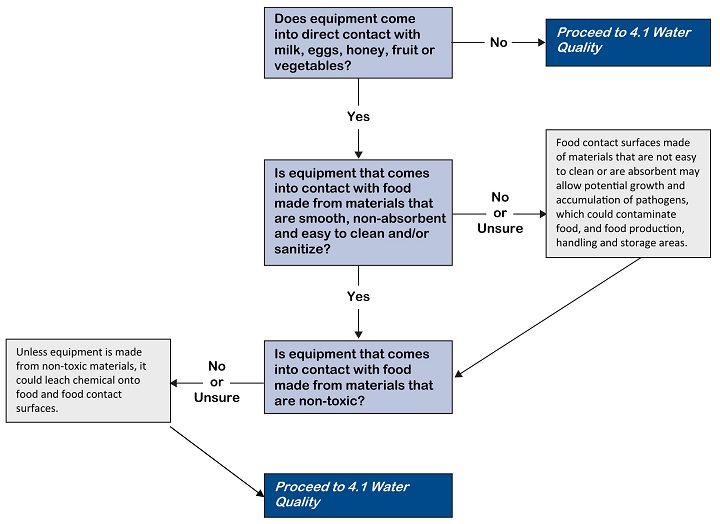Equipment - 3.2 Equipment design, construction & installation
Equipment that is improperly designed, constructed or installed may create and/or result in contamination of food.

This good agricultural practice applies to farms that have equipment that comes into contact with milk, eggs, honey, fruits or vegetables.
What needs to be done
Make sure equipment is designed, constructed, and installed to facilitate the safe production of food.
How to do it
Make sure equipment is suitable for its intended use.
Make sure equipment is designed and installed for easy cleaning, sanitizing, service and maintenance.
When designing, constructing or installing equipment, ask your suppliers for appropriate materials, or refer to the reference listing of accepted construction materials, packaging materials and non-food chemical products (Canadian Food Inspection Agency).
Other considerations
Make sure food contact surfaces are made from materials that are smooth and non-absorbent to promote effective washing, cleaning and drying.
Use materials that are non-toxic to food. For example, chemicals seeping from plastic or lead leaching from lead solder can contaminate food.
Make sure equipment is durable in order to reduce physical hazards (for examples, metal fragments falling off the equipment).
If you have an audit
Be prepared for the auditor to observe the equipment design, construction and installation.
Laws and regulations
There are few laws that impact on food safety requiring specific equipment design, construction and installation in agricultural production. Generally, these requirements are laid out in laws regarding the processing of meat, fish and other food products, including egg-grading stations, which are outside the scope of this document.
The Milk Industry Standards Regulation, Reg. 464/81, s. 25, s. 31, s. 42 under the Milk Industry Act set out specifications for a milk house, including location, space, floor, drains, walls, lighting, doors, screens, ventilation, sinks, hot and cold water, hose port and toilet. S. 35 (1) requires that the utensils and equipment used in the production, cooling, handling, storing or conveying of milk shall be of a type and material equivalent to 3A Standards, and conform to the “B.C. Standards for the Design, Fabrication and Installation of Milking and Milk Handling Equipment”. S. 36-42 provide detailed construction, materials, and other specifications for the farm holding tank and the requirements for its use (e.g. all measuring rods used to measure milk in farm holding tanks shall be of stainless steel or equivalent).
| Go back to 3.1 Equipment maintenance & calibration | Proceed to 4.1 Water quality |
